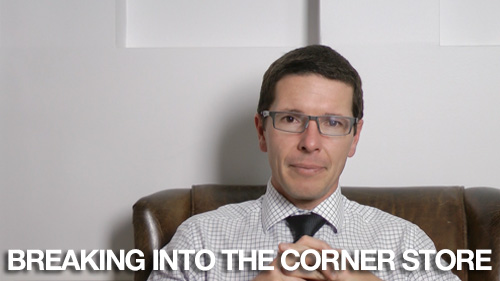Breaking into the corner store (14/05/2013)
Roger Montgomery is the Founder and Chairman of Montgomery Investment Management. Roger has over three decades of experience in funds management and related activities, including equities analysis, equity and derivatives strategy, trading and stockbroking. Prior to establishing Montgomery, Roger held positions at Ord Minnett Jardine Fleming, BT (Australia) Limited and Merrill Lynch.
This post was contributed by a representative of Montgomery Investment Management Pty Limited (AFSL No. 354564). The principal purpose of this post is to provide factual information and not provide financial product advice. Additionally, the information provided is not intended to provide any recommendation or opinion about any financial product. Any commentary and statements of opinion however may contain general advice only that is prepared without taking into account your personal objectives, financial circumstances or needs. Because of this, before acting on any of the information provided, you should always consider its appropriateness in light of your personal objectives, financial circumstances and needs and should consider seeking independent advice from a financial advisor if necessary before making any decisions. This post specifically excludes personal advice.


Karin Hefftner
:
Hi Roger,
How far below the IV would the market price of Flight Centre have to fall before you would consider adding to you holdings?
Roger Montgomery
:
Great question. When it comes to margins of safety; too much of a good thing is wonderful. I would like to see at least 10% but 20% or 50% is even better. There’s no right answer Karin because we cannot forecast how low the price will go or even if it will go down!
Andrew Legget
:
Thought i might throw my approach into this for discussion, which i am sure has some flaws in it which is another reason i don’t mind putting it out there. Like Roger, the larger Margin of safety the better but I also wanted a systematic way of putting a minimum required level.
The main basis of my approach is that some businesses are more unpredictable than others and there for different companies need a larger MOS than others to compensate you for the fact that actual results may be different to the inputs used to come up with my valuation. So it is a bit of an insurance premium as to how wrong i will be (Show me someone who can value the future with 100% precision).
So what i have been using is what i refer to as a ROETA (i like giving things fancy names). This is the standard deviation of the companies ROE over ten years expressed as a percentage. To this i add an expected return or a minimum return i would like to earn on the investment.
This then will give me a minimum point where a company is trading at a big enough discount for me to purchase. Leaving the discount rate to cater for the other parts of risk which are not reflected in my valuation (more market risk).
So in the example of flight centre, lets assume i have an expected return of 10% and a ROETA of 2.59% so i would wait until the price was at a discount of 12.59% before allowing myself to consider purchasing.
One thing i am considering is to subtract future IV growth from the total but not sure if it fits into my valuation approach.
Happy to hear anyones thoughts on this approach particulary the cons about it. I think what it does do is help compensate for unpredictability and adjusts due to the stage of the life cycle the company is in as mature companies tend to be lower than beginning and growing companies.